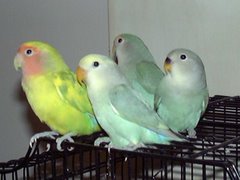What Kind of Perches are Better for Lovebirds?
 Perches for lovebirds are an important criteria for making them happy (???) in the cage. The girth of the perch should be more than the diameter of the lovebirds wrapped feet. i.e. the lovebirds foot does not wrap completely around the perch. This is an important criteria in selecting perches for your lovebirds. There are two types of perches available for lovebirds viz., natural perches and cement perches.
Perches for lovebirds are an important criteria for making them happy (???) in the cage. The girth of the perch should be more than the diameter of the lovebirds wrapped feet. i.e. the lovebirds foot does not wrap completely around the perch. This is an important criteria in selecting perches for your lovebirds. There are two types of perches available for lovebirds viz., natural perches and cement perches.
Natural Perches
If you want to provide comfort to your lovebird, then natural perches are the best not only for resting but also for chewing. The normal behavior of the lovebirds is removing bark and demolishes the perches. So you need to replace the perch regularly.
While selecting natural perch from trees, you should be careful that the branch should be devoid from pesticides or insecticides. Any how, it is better enough to clean the perch material with 10% bleach solution.
The natural perches for your lovebirds include willow, poplar, pine, manzanita, mulberry, fir, elm, dogwood, crabapple, cottonwood, cactus wood, birch, beech, ash, and apple.
Cement Perches
Some of the lovebirds owner prefer cement perches, which helps in trimming their nails. As these perches are very hard, place them in the place where your lovebird goes everywhere but spent not much of time.
The ideal place for placing these cement perches are just in front of food and water dishes. You will have to clean these lovebirds perches frequently as they use these as an area to wipe its beak. The optimal size of th cement perches would be in such a way that the foot ought to go 3/4 of the way around the perch.
Lovebirds perches are really an important thing to be selected with utmost care to avoid bumble foot and beak disorder(pecking). So perfect perches for your lovebird will definitely help to keep them hale and healthy.









 Free Ads For Bloggers
Free Ads For Bloggers

